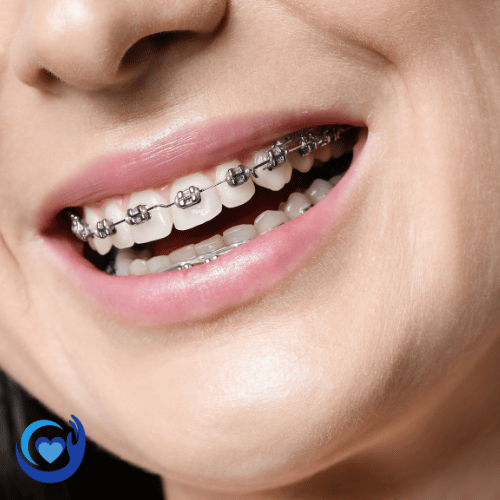Book Appointment Now
Learn More about Smile Correction (aka. Orthodontics)
Smile correction through orthodontics involves the use of braces or clear aligners to straighten and align teeth, improving bite and overall dental health. This procedure enhances the appearance of the smile and can boost self-confidence. Anesthesia is normally not required.

Orthodontics can help you with:
- Straightening misaligned or crooked teeth.
- Correcting bite issues such as overbite, underbite, crossbite, and open bite.
- Closing gaps and spaces between teeth.
- Improving overall dental health by making teeth easier to clean and reducing the risk of tooth decay and gum disease.
- Enhancing the appearance of your smile, leading to increased self-confidence.
You may be a suitable candidate for orthodontics if:
- You have misaligned, crooked, or crowded teeth.
- You have bite issues that affect your ability to chew or speak properly.
- You are in good overall dental health, with no active gum disease or tooth decay.
- You are committed to maintaining good oral hygiene and attending regular orthodontic appointments.
- You are motivated to follow the orthodontist’s instructions and wear braces or aligners as directed.
What Happens During the Procedure?
Getting your braces or aligners is a quick, painless process that sets you up for your smile transformation. Here’s what happens:
- We take detailed images and impressions of your teeth
- Your orthodontist creates a custom plan for your perfect smile
- If you choose traditional braces, small brackets are bonded to your teeth
- A thin wire connects the brackets to begin guiding your teeth
- For clear aligners, you’ll receive your first set of custom trays

General Schedule – Standard Package for Orthodontics
- Before you arrive:
- Participate in an online meeting with your in-country advocate and our consulting doctor who will manage your case.
- You will then be referred to one of our specialists for an online consultation.
- Have a pre-travel meeting with your in-country advocate to finalize your itinerary.
- Day 1 – Arrival day:
- Arrive in Colombia, where your advocate will greet you at the airport.
- Transportation to your hotel will be provided.
- Your advocate will give you a welcome briefing at the hotel.
- Day 2 – Preparation day:
- Your advocate will meet you at the hotel.
- Transportation to your pre-procedural consultation with your specialist will be arranged.
- Discuss and prepare for your procedure with the guidance of your advocate.
- Day 3 – Procedure day:
- Your advocate will meet you in the morning and accompany you to the clinic for your procedure.
- After the procedure, your advocate will assist you and transport you back to your hotel for recovery.
- Day 4 – Recovery day:
- Dedicate at least one full day to recover after the procedure.
- This day will ensure you are ready for travel and that the procedure has been successful.
- If you feel well enough, engage in light activities. Transport and advocate support will be available throughout the day.
- Day 5 – Travel day:
- Your advocate will meet you at the hotel for your departure.
- Transportation to the airport will be provided.
- Your advocate will assist you until customs.
What to expect before, during, and after the orthodontic treatment?
Before Treatment:
- You will have a consultation with an orthodontist to discuss your goals, dental history, and any concerns.
- Dental X-rays, photographs, and impressions of your teeth may be taken to plan your treatment.
- The orthodontist will create a customized treatment plan based on your specific needs.
During Treatment:
- Braces or clear aligners will be applied to your teeth.
- Regular adjustments or new sets of aligners will be provided periodically to gradually move your teeth into the desired position.
- You may experience some discomfort or pressure on your teeth after adjustments, which should subside within a few days.
After Treatment:
- Once your teeth have been properly aligned, braces will be removed, or you will stop using aligners.
- You will likely be given a retainer to wear, which helps maintain the new position of your teeth.
- Follow your orthodontist’s instructions on how to care for your teeth and retainer.
- Attend regular dental check-ups and maintain good oral hygiene to keep your smile healthy.
Recovery After Your Treatment Begins
Let’s walk through your smile journey:
First Week
The first few days with braces or aligners take some getting used to. Your teeth might feel a bit tender – totally normal as they start their moving process. Soft foods are your friends right now, and we’ll give you special tools to help keep everything clean. Most people say it’s more about adjusting to the feeling than dealing with any real discomfort.
Weeks 2-3
By now, you’re probably getting used to your new hardware! The initial tenderness is gone, and you’re mastering the art of brushing around brackets or popping aligners in and out. You might even notice tiny changes in your teeth already – many patients say they can feel their bite shifting slightly. You’re back to most normal foods (though remember to avoid the ones we listed).
Months 1-6
This is when things get exciting! You’ll visit us every few weeks for adjustments (or new aligners), and each time you’ll see more progress. After adjustments, you might feel a little pressure for a day or two – that’s just your teeth doing their work. Photos are great during this time – you’ll be amazed at the monthly changes!
Long-term Results
Most treatments take 12-24 months, depending on your case. Every smile is different! When we remove your braces or you finish your last aligner, you’ll see your brand new smile – and we’ll give you retainers to keep it that way. The best part? These results are yours to keep, as long as you wear those retainers as directed. Most patients tell us the journey was totally worth it for a lifetime of confident smiling!
- In-country ground transportation,
- In-country concierge service,
- Stay at a comfortable 4 Star Accommodation,
- Consultation and orientation with our in-house doctor,
- Medical Procedure,
- Travel insurance.
FAQs – Here we answer your common questions about Orthodontics
The duration of orthodontic treatments varies, but they typically last between 18 months to 3 years, depending on the complexity of the case.
Orthodontic treatments can significantly improve your smile, boost self-confidence, and enhance oral health by correcting misaligned teeth and bite issues.
Orthodontic procedures, such as getting braces, are usually done on an outpatient basis, meaning you can go home the same day. Each appointment typically lasts about 30 minutes to an hour.
There is no significant recovery time after getting braces, but it may take a few days to a week to adjust to the new appliances in your mouth.
Most patients can return to work or school immediately after their orthodontic appointment, though you might experience some discomfort for a few days.
The process of getting braces is not painful, but you may experience some discomfort or soreness for a few days after the braces are applied or adjusted.
Orthodontic treatments are generally safe and effective when performed by a qualified orthodontist. As with any medical treatment, there can be risks and potential complications, which should be discussed with your provider.
Many patients find orthodontic treatments worth it due to the significant improvements in dental function, appearance, and overall oral health. The decision should be made after thorough consideration and consultation with a qualified orthodontist.
Orthodontic treatments do not typically leave scars. Any discomfort or changes in the mouth usually resolve once the braces are removed and treatment is completed.
The information provided here within should not be construed in any way as medical guidance or advice. Please consult with your medical physical or health provider. Information provided is for informative purposes only and may not capture all pertinent laws, standards, and best practices. The medical field is continually evolving; information mentioned may be outdated and/or could undergo changes. The interpretations presented are not official. Some sections are based on the interpretations or views of relevant authorities, but we cannot ensure that these perspectives will be supported in all professional settings.
